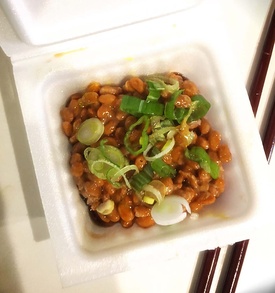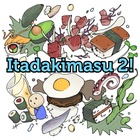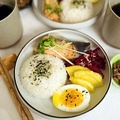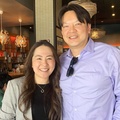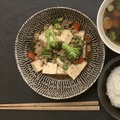I love natto. But it wasn’t always that way. My mom gave me my first taste when I was around seven or eight years old and it didn’t go well. I gagged and begged her for a cup of water to wash the bitter taste out of my mouth. “It’s good for you,” she said, but I swore right then that not a single, slimy, smelly bean would ever touch my lips again.
Growing up, I put it on the same list with things like tamago gohan and tazukuri—weird foods that my parents and grandparents ate that I wouldn’t touch. When you’re a kid, there’s nothing more embarrassing than bringing friends home for an afternoon of Monopoly only to find a snack laid out of tiny, dried sardines. Couldn’t we just gorge ourselves on mayonnaise sandwiches like normal people?
And then there was that story my mom told us. As a little girl, she was cleaning the house one day and stumbled upon a large, odd-smelling box under a bed. Her mom told her that it was a batch of homemade natto fermenting, which gave new meaning to the phrase “monster under the bed.” How could anyone even think of eating something that might have been stewing right next to a cluster of dust bunnies and grandma’s slippers?
But I remember the moment my feelings took a surprising turn. I was in middle school and came home one day to find my mom savoring a bowl of hot rice topped with natto and freshly chopped scallions. It looked so good—could I have been wrong all these years? She offered me a small bite and I was instantly in love. “I told you so,” she said. I guess you could say my natto heart grew three sizes that day.
For the uninitiated, natto is a traditional Japanese dish made out of fermented soy beans. Its aroma has been compared to that of old socks, or bad cheese, or old socks filled with bad cheese. The beans are slimy, and held together by a stringy substance that looks like someone might have sneezed right into your bowl. You get the picture. My mom was right about its health benefits, though—natto is a great source of protein, rich in vitamins, and a natural probiotic. Digestive health could be yours if you could just get past the smell.
It’s definitely an acquired taste, and not exactly popular with the kids. When I was visiting with relatives in Japan a few years ago and excitedly ordered a dish of natto, my younger cousins pointed out that nobody ordered the old-fashioned dish anymore, even in the small, traditional town we were in. I wasn’t sure if it was true, or they were just giving me a bad time because I’d made them drive five miles out of our way that morning to get me to a Starbucks.
There are few restaurants in the U.S. that serve natto, even in Los Angeles where sushi bars and Japanese restaurants are practically on every corner. And if you find it and order it, prepare to be judged—I ordered a natto roll while having lunch with a friend and he immediately asked if I had taken off my shoes. His reaction was typical, but I prefer to save my outrage for people who commit truly horrible offenses like dousing their rice with soy sauce.
Even in my own home, natto isn’t exactly welcome. I have to yell out, “natto” before I eat it so the rest of the family can clear the room, and they scatter as if I’d just shot up a flare to signal some terrible, catastrophic event. (I have to admit it works great when you just want some time to yourself.) My older daughter actually used to like it when she was a toddler, but she refuses to eat it now, and insists it was just a weird phase, like leg warmers or Miley Cyrus.
But here’s the thing: I know that it won’t be long before natto has its day. Remember, there was a time that everyone thought that raw fish was disgusting, and now you can get a spicy tuna handroll at a gas station in Ohio. Soon my beloved dish will be “Columbused” just like most ethnic foods, and you’ll be seeing a Bon Appétit video featuring a chef from Austin talking about the dish he invented using natto and beet foam and served in a mason jar.
Sometimes food is just food. But sometimes it’s a memento from our past, a way of connecting with someone we love when that person is no longer here to sit at the table with us.
I still eat natto all the time, and I think of my mom when I do. She passed away last year, and during her last days when eating became almost impossible for her she asked for natto and rice. I would fill up a bento box and take it to the hospital, and I would feed her one bean at a time along with a few grains of rice. While she refused at first, eventually she would take the smallest bite and chew it slowly with her eyes closed. It was difficult to tell, but she seemed to enjoy it because a faint smile would cross her face. “It’s good for you,” I’d say as I held her hand.
© 2017 Marsha Takeda-Morrison


